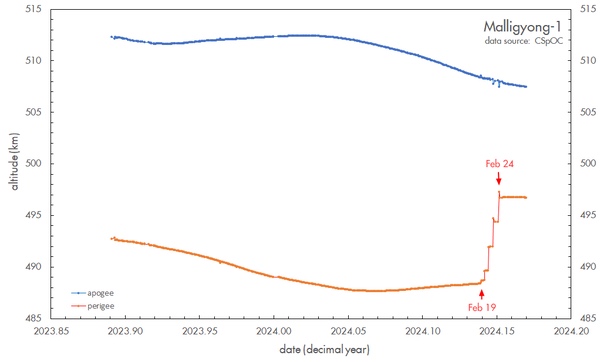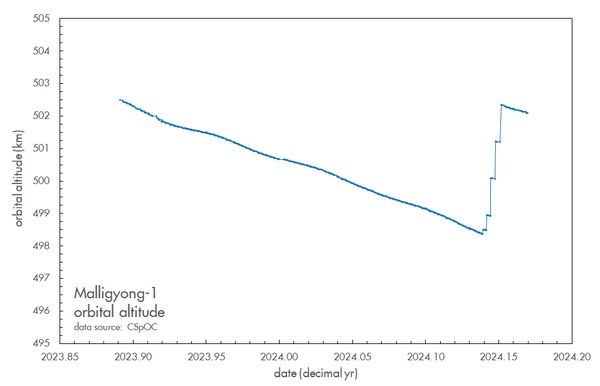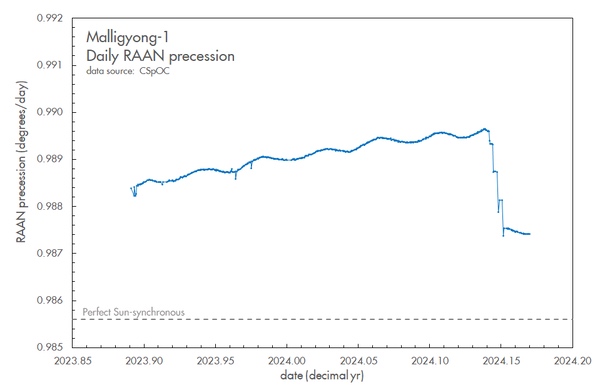A North Korean satellite starts showing signs of lifeby Marco Langbroek
|
 A diagram showing the evolution of apogee and perigee altitudes for Malligyong-1 since launch late November 2023, based on US tracking data. Note the stepwise raise in perigee altitude on the right in the diagram. |
The series of small maneuvers raised the perigee altitude (the lowest point in its elliptical orbit) by nine kilometers, from 488 to 497 kilometers. In the process, it also circularized the orbit, reducing the orbital eccentricity to half the former value. The net effect was that the average orbital altitude was raised to 503 kilometers, the initial value from November 2023, correcting for all orbital altitude lost since then, and that the daily precession of the ascending node (which had been slightly growing over time) was reduced to a value closer to the ideal value of 0.986 degrees/day, in order to preserve the Sun-synchronous character of the orbit. The latter is important for an optical reconnaissance satellite: Sun-synchronous basically means that the satellite will pass over a certain spot on Earth at roughly the same time each day, which makes it more easy to compare images taken on different days for any changes in the surveyed areas.
 A diagram showing the change in average orbital altitude. The orbit raise late February brought the orbital altitude back to its original value of 503 kilometers. |
 A diagram showing the rate of RAAN (ascending node) precession. The orbit raise and circularization late February lowered the rate to a value closer to the ideal sun-synchronous value of 0.986 deg/day. |
Malligyong-1 maneuvering to raise its orbit is kind of a big deal. First, it shows that the satellite is not “dead,” unlike some western sources suggested, but functional—with the caveat that we do not know whether the onboard camera is actually taking images. Second, it underlines that the North Koreans have clear control over the satellite, including its attitude, and can modify its orbit. While this in and of itself might not seem to be a big feat, it is for North Korea, and pushes back against western efforts to downplay the technological advances North Korea is making in its space program.
| It seems counterintuitive that a country, impoverished to the point where its citizens go without electricity and lack food, can build and launch functioning satellites, but clearly North Korea can. |
A third implication of the demonstrated capacity to maneuver is that North Korea can now actively prolong the orbital lifetime of their satellites by doing periodic orbit raises. Their previous two satellites, KMS 3-2 and KMS 4, had an orbital lifetime of 12 and 8 years, respectively: due to natural orbital decay, their orbital altitudes progressively got lower and lower until the satellites both reentered into the atmosphere in 2023. With Malligyong-1’s capacity to raise its orbit, they can now postpone that process, and prolong operational value at an operationally meaningful altitude, as long as the satellite has fuel left on board.
This is the first time that a North Korean satellite has shown the ability to do orbital maneuvers, and to many analysts (including me) this ability comes as a bit of a surprise. It serves as a warning and wakeup call. There is a tendency among certain western pundits to routinely underestimate the technological level of North Korea’s ballistic missile and satellite programs. It seems counterintuitive that a country, impoverished to the point where its citizens go without electricity and lack food, can build and launch functioning satellites, but clearly North Korea can. To North Korea’s leadership, the missile and space program is vital for regime survival and hence gets a strong priority in funding.
Note: we are now moderating comments. There will be a delay in posting comments and no guarantee that all submitted comments will be posted.
